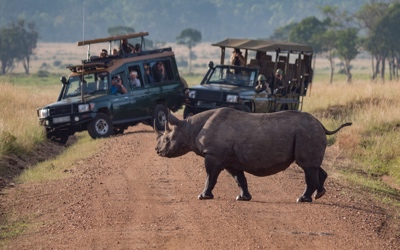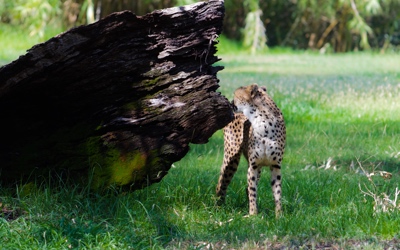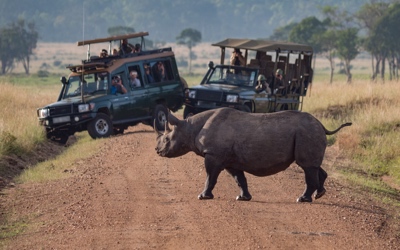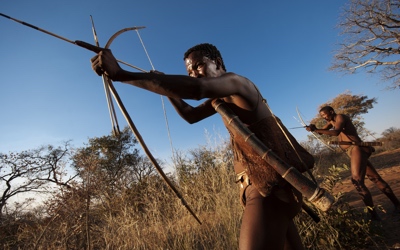
Climb Mount Kilimanjaro: 6 Days Machame Route
6 days
Instant confirmation
About this activity
DAY 1: MACHAME GATE (1790METERS) TO MACHAME CAMP (3010METERS)
The first day trekking begins at Machame Gate normally one hour’s drive from Moshi lies the gate to the Machame route. At the Gate you will meet your trekking crew, your guide, porters and cooker. There will be a flurry of activity as porters assemble gear for the trek, where we complete park formalities. The first section of the route climbs steadily and passes through magnificent, dense rainforest. This path is less well-trodden so it can get somewhat overgrown in places and it is often wet and muddy underfoot.
DAY 2: MACHAME CAMP (3010METERS) TO SHIRA CAMP (3845METERS)
The trek is relatively steep as you enter the low alpine zone which is characterized by moorlands and grasslands. Shira Camp 2 sits on a plateau which provides you with the first views of Kibo in the North-West and Mount Meru in the East.
DAY 3: SHIRA CAVE (3845METERS) TO BARRANCO CAMP (3960METERS)
Day three, walking now on high moorland, the landscape changes the entire character of the trek. The day has been spent at altitude (up to 4600m), Although you end the day at a very similar elevation to when you started from Shira Camp, it is arguably one of the most important days on your trek as it gives you a chance to climb high and sleep low which is important for proper acclimatization.
DAY 4: BARRANCO CAMP (3960METERS) TO BARAFU CAMP (4640METERS)
Day four on the Machame Route begins by descending into the Great Barranco, a huge ravine. We then exit steeply, up the Great Barranco Wall, which divides us from the southeastern slopes of Kibo. It’s a climb over rock, not technical, but long and tiring. Passing underneath the Heim and Kersten glaciers, we head towards the Karanga valley, which is our last stop for fresh water before the summit.
DAY 5: BARAFU CAMP (4640METERS) TO UHURU PEAK (5895MWTERS) & DOWN TO MWEKA CAMP (3100METERS)
Day five is summit night (and day)! We start off at around midnight, and walk steeply upwards to the summit glaciers. We will be climbing scree for 4 to 5 hours but gain incredible height over a short distance. The views are spectacular. Another hour’s walking takes us to the summit, Uhuru Peak (5895m). We begin our descent by returning to Stella Point and then descending on scree slope and track back to Barafu Camp for breakfast.
DAY 6: TREK MWEKA CAMP (3100METERS) TO MWEKA GATE (1630METERS)
Day six is the final day of trekking on the Machame Route. A gentle trek takes us down through the rainforest to Mweka Gate, where we complete park formalities and receive certificates, which you can hang up with pride! We are then met by our vehicles and return to the hotel in Moshi, where you can treat yourself to a welcome shower then celebrate with cold drinks. Overnight at your arranged Hotel
Read more
Show less
The first day trekking begins at Machame Gate normally one hour’s drive from Moshi lies the gate to the Machame route. At the Gate you will meet your trekking crew, your guide, porters and cooker. There will be a flurry of activity as porters assemble gear for the trek, where we complete park formalities. The first section of the route climbs steadily and passes through magnificent, dense rainforest. This path is less well-trodden so it can get somewhat overgrown in places and it is often wet and muddy underfoot.
DAY 2: MACHAME CAMP (3010METERS) TO SHIRA CAMP (3845METERS)
The trek is relatively steep as you enter the low alpine zone which is characterized by moorlands and grasslands. Shira Camp 2 sits on a plateau which provides you with the first views of Kibo in the North-West and Mount Meru in the East.
DAY 3: SHIRA CAVE (3845METERS) TO BARRANCO CAMP (3960METERS)
Day three, walking now on high moorland, the landscape changes the entire character of the trek. The day has been spent at altitude (up to 4600m), Although you end the day at a very similar elevation to when you started from Shira Camp, it is arguably one of the most important days on your trek as it gives you a chance to climb high and sleep low which is important for proper acclimatization.
DAY 4: BARRANCO CAMP (3960METERS) TO BARAFU CAMP (4640METERS)
Day four on the Machame Route begins by descending into the Great Barranco, a huge ravine. We then exit steeply, up the Great Barranco Wall, which divides us from the southeastern slopes of Kibo. It’s a climb over rock, not technical, but long and tiring. Passing underneath the Heim and Kersten glaciers, we head towards the Karanga valley, which is our last stop for fresh water before the summit.
DAY 5: BARAFU CAMP (4640METERS) TO UHURU PEAK (5895MWTERS) & DOWN TO MWEKA CAMP (3100METERS)
Day five is summit night (and day)! We start off at around midnight, and walk steeply upwards to the summit glaciers. We will be climbing scree for 4 to 5 hours but gain incredible height over a short distance. The views are spectacular. Another hour’s walking takes us to the summit, Uhuru Peak (5895m). We begin our descent by returning to Stella Point and then descending on scree slope and track back to Barafu Camp for breakfast.
DAY 6: TREK MWEKA CAMP (3100METERS) TO MWEKA GATE (1630METERS)
Day six is the final day of trekking on the Machame Route. A gentle trek takes us down through the rainforest to Mweka Gate, where we complete park formalities and receive certificates, which you can hang up with pride! We are then met by our vehicles and return to the hotel in Moshi, where you can treat yourself to a welcome shower then celebrate with cold drinks. Overnight at your arranged Hotel
Included
- Accommodation
- Accommodation prior and after to climb(Including breakfast sharing twin room)
- During the climb you will share tent with 1-2 other climber
- Warm and comfortable sleeping pads(2 inches thick)
- Meals
- Breakfast
- Lunch
- Dinner
- Park fee
- Kilimanjaro National Park permits.
- Kilimanjaro National Park rescue fees
- Camping/hut fees
- Trip Crew
- Professional mountain crew (with over 6 years of experience in climbing)
- Each climber will be provided with a porter(who can carry up to 15 kg of personal baggage
- Transport
- Pick up at International Airport
- Transfer to the hotel As per arranged
- Return transfer to Kilimanjaro airport.
- Transfer to the trail head
- Free equipment’s
- Modern tents
- First aid kit
- Warm and comfortable sleeping pads (2 inches thick)
- Portable flush toilets can be provided for free upon clients request
- Group equipment (dining tent, table, chairs, crockery and cutlery)
- Additional Services
- Meeting at Kilimanjaro International Airport
- Oxygen systems and pulse oximeters
- Bottled water
- Coffee and/or Tea
Not included
- Gear
- Personal gear rental
- Tipping on climbing from the climbing group (not per climber)
- Guide $15 – $20 per day
- Cook $10 – $15 per day
- Porter $8 – $10 per day
- Flight
- International Flights and Insurance
- Visa
- 100 per person for US Nationals and $50 per person for other Country Nationals
- Meals
- Lunches, dinners and drinks at your hotel in Moshi before and after climbing
- Personal items
- Laundry
- Toiletries
Additional
- Confirmation will be received at time of booking
- Wheelchair accessible
- The short answer to the question: Can anyone climb Mount Kilimanjaro? Is obviously no.
- If you are super young or ridiculously old you will unlikely be able to cope with what Kilimanjaro throws at you. Equally, if you are obese or severely disabled you can probably write Kilimanjaro off your bucket-list.
- For the average person though, being able to successfully climb and summit Kilimanjaro is definitely attainable. You don’t need to be particularly fit and you do not need any technical climbing skills.
- Children over the age of 10 can legally have a go, as can older generations in their 60s and 70s. And all you need is determination and then willing to get to the summit.
- The real challenge with climbing Kilimanjaro is the altitude and the rate of ascent.
- Standing at 5,895 meters (19,341 feet), Kilimanjaro is firmly classified as an extreme altitude mountain trek. At high altitudes the body is susceptible to a condition called Acute Mountain Sickness (AMS) or altitude sickness.
- As many as 50% of people who climb Kilimanjaro suffer from AMS symptoms, often mild and moderate variants. However, more severe complications such as High Altitude Cerebral Edema and High Altitude Pulmonary Edema are also possible on Kilimanjaro, and can be fatal.
- Longer routes provide more time to properly acclimatize and therefore success rates are higher. Seven day routes are our preferred option for trekkers
- Routes that offer a climb high, sleep low acclimatisation day are preferable the Machame route and Lemosho route provides the best climb high, sleep low opportunity
- Go slowly through- out your trek. Do not over-exert yourself. Conserve energy at all times. You will hear your porters say ‘Pole Pole’, this means Slow, Slow in Swahili. Listen to them
- Drink loads of fluids (3-4 liters of water a day)
- Mount Kilimanjaro is the highest mountain in Africa and hiking to the peak is a challenge that should not be under estimated. With all the information you could possibly gather, added to being physically prepared, one’s chances of reaching the summit is substantially increased. Stamina and mental determination to a great extent.
- The type of fitness is more important than the degree of fitness. Climbing Mt. Kilimanjaro is a hike, therefore the best preparation one can do is to hike, preferably under simulated conditions. Although jogging could be beneficial to your fitness level, it does not fully prepare your muscles for a strenuous 6-day hike. We suggest that you spend some of your training by merely hiking. In addition to regular gym workouts, make sure you also go for walks in order to stimulate relevant muscle development. Try to do a one or two day hiking trials in your area. This will not only be an excellent way for physical preparation, but also an enjoyable means to prepare yourself mentally.
- Important points to remember – Before you start!!· Medical Check-up
- Before embarking on a fitness program, it is always wise to first seek the advice of a medical doctor. Feel free to share this program with your family doctor for input. Chances are, your doctor will be delighted to know that you undertake to exercise regularly.
- Guides and porters are compulsory for all routes on Kilimanjaro. The importance of having competent, high quality guides cannot be overstated when it comes to climbing Mount Kilimanjaro. All weather adventure has the best local guides, all of whom are fluent in English and have received extensive training in first aid, mountain rescue, flora and fauna, and history. It is not allowed to climb Kilimanjaro without a guide.
- In terms of important factors contributing to a successful summit attempt. For the duration of your Kilimanjaro trek:
- Guide will be your advisor.
- Guide will lead you to the summit.
- Guide will bring down safely again.
- It will be important that you work closely with him and take note of his advice.
- Our Kilimanjaro guides are very experienced and professionals who intimately know the mountain. You can expect the following from our Kilimanjaro guides:
- Guides are required for all routes on Kilimanjaro. All our treks up the mountain are lead by highly trained and qualified guides, registered with the Kilimanjaro National Parks Board.
- Our guides are well prepared to handle any situation one can encounter on the mountain. Each of our guides has been selected over years, based on experience, safety record and through feedback from previous clients.
- With this training and experience, they are completely acclimatized to high altitude and are adapted to mountain life. Climbing Kilimanjaro has become second nature to them. Our guides are tough as nails and can teach you everything you need to know about high altitude trekking
- Your safety is the highest priority for us. Our clients put their lives in our hands and trust us to keep them safe, which means they have the tools to make critical medical and evacuation decisions. They receive annual training in emergency first aid and can prevent, recognize and treat altitude-related illnesses.
- With our professional guide you have assurance to climbing Kilimanjaro. Therefore it is importance that your expectations are met or exceeded. All weather adventures take pride in the hard work of our staff and we strive to maintain and grow our reputation of excellence. Our guides uphold a high level of professionalism while still keeping the experience fun for the clients
- Our guides are knowledgeable about general mountain facts. They can tell you about the climate zones, the altitudes of and distances to campsites, and information about the geology, flora and fauna.
- The average ratio of our support staff to climbers is 2 to 3 porters per hiker and two guides for a maximum of 4 hikers. This excellent staff to client’s ratio, bolstered by our superior support equipment, will ensure your safety and enjoyment on the mountain.
- Porters and cook
- The porters do not only transport your gear and the supplies up and down the mountain. Arriving at every camp site long before you, they will have already erected your tent on your arrival. In the evening they will also boil drinking and washing water and the cook will prepare dinner of a quality that has surprised many previous clients.
- Weight limits for porters
- Remember that there is a
- on the gear of each hiker to be portered. A soft duffel bag (barrel type) is preferred a rucksack is not necessary as they prefer to porter the loads balanced on their heads and shoulders.
- Tipping
- This is a
- on every Kilimanjaro climb. We recommend giving a tip of between US $ 200 to US $ 250 per climber to the mountain crew at the end of the climb. The exact tipping amount depends on group size and how many days were spend on the mountain. We recommend giving the tip to the main guide who will then distribute the tip among the mountain crew.
- All weather adventures struggle to have the best porters through fair and honest treatment of our staff. We ensure that:
- Our porters are paid immediately upon completion of a trip
- Our porters are paid more than the standard compensation on Kilimanjaro.
- Our porters are paid tips in a fair, transparent manner.
- Our porters are fed three nutritious meals per day, in adequate amounts, of their preferred local foods.
- Our porter loads are limited to 15 kilogram.
- Our porters have the proper gear and equipment to handle the mountain. Their clothing, sleeping bags and tents are sufficiently warm and/or waterproof.
- Mount Kilimanjaro routes and their variations take between five to nine days to complete. Although Mount Kilimanjaro is known as a "walk-up" mountain, you should not underestimate it and its risks. The overall statistics show that less than half of all climbers reach the summit.
- A perfunctory analysis of the KINAPA (Kilimanjaro National Park Administration) records show that only 45% of climbers reach Peak Uhuru. These information is long outdated (the latest report was published in 2006), and the achievement rate has probably somewhat increased since those days because of emergence of the longer trails, improved infrastructure and equipment, increased awareness of pitfalls of choosing short treks, etc
- Every outfitter knows this, but unfortunately it seems some don't mind attracting customers with misleading or blatantly false statements. The truth is that each of these figures are statistically impossible! or leading climbs only on 8-9 day routes, achieving those extraordinarily high success rates would be impossible to maintain for even a short period of time.
- It is possible to climb the mountain in
- or
- days, but why take the chance? Some clients want to minimize their days in order to save costs, which is understandable. But we feel that the additional cost is well worth it. Not only is it safer, but you increase the probability of your success, have more time to enjoy the experience.
- Why you travel far away to climb Mount Kilimanjaro and opt few days that reduce your success rate to summit? How would you feel if you scheduled a route with the minimum required days, only to have to turn around within the first couple days because the rate of ascent was too quick? Wouldn't you rather have added a couple days to your trip to give yourself a better chance, to be fairer to your body? Were the 'savings' you got for not taking additional days worth in order of:
- Cutting cost and make your climb short,
- not making it to summit, or even worse,
- Putting your health at risk?
- Many climbers often choose 5-day or 6-day treks to reduce the price. However, since Kilimanjaro climbing adventure is not cheap, though affordable, adventure overall, the difference in price for a 5 or 6-day adventure and 7-day one is not overly significant. Apart from safeguarding your organism against unnecessary distress, spending one or two days more on Kilimanjaro will you a chance to explore the areas, which may otherwise escape your attention.
- Overall, you should take the question “how long to climb Mount Kilimanjaro” very seriously. However unimportant it may seem, deciding how many days to climb Kilimanjaro is one of the most important elements of your travel preparations.
- Make sure you have everything you need to help you successfully summit the Roof of Africa.
- Valid passport and visa
- Airline ticket
- International health card with immunizations (Yellow fever)
- Travel insurance
- Medical insurance
- US$ cash / Travelers Checks / Credit Card
- Duffel bag – large enough for all climbing gear and clothing. To be carried by the porters. An extra bag to be left at the hotel with extra gear
- Small luggage lock – to lock zippers
- Day backpack – between 20 – 35 litres. Large enough to carry your water, camera, raincoat, lunch pack, snacks & warm clothing
- Sleeping bag
- Ski-pole / walking stick
- Water bottle / containers
- Kilimanjaro map (Can be bought at Park gate)
- Waterproof, breathable & windproof jacket (outer wear like Ventex, Gore-Tex or Jeantex)
- Waterproof, breathable & windproof pants (outer wear)
- Polar fleece (middle layer)
- Thermal underwear (under layers)
- Mittens or warm gloves
- Glove liners (if necessary)
- One pair thermal (polertex) socks
- Balaclava
- Gaiters
- Thermal water flask
- Shorts
- Hiking pants
- Regular underwear
- T-shirts
- Raincoat or Poncho
- Water resistant semi-stiff hiking boots – mid weight boots work great
- Shoes for overnight camps – i.e. sneakers, running shoes, etc.
- Socks – several pairs for the climb
- Liner socks – to keep your feet dry and limit the risk of blisters
- Sun hat or similar (with a brim)
- Collapsible ski stick (optional but highly recommended)
- Water bottles – two or three (total capacity at least 4 litres)
- Head lamp, good strong one with spare batteries and an extra light bulb
- Water purification tablets
- Sunglasses, good quality dark lenses for the climb, with a securing strap
- Flashlight (torch) with spare batteries
- Toilet kit (soap, tooth brush, toilet articles, wet wipes, etc.)
- Towel
- Sun screen and lip protection, SPF 30+
- Ziploc bags, to protect camera, binoculars, etc. from dust
- Toilet paper
- Money belt for passport and valuables
- Headache tablets
- Altitude sickness-Diamox (if not allergic to sulpha)
- Diarrhoea – Imodium
- Nausea – Valoid
- Malaria – Prophylaxis
- Water purification tablets
- Painkillers
- Muscular sprains
- Abrasions blisters and cuts – Plaster, bandages
- Antiseptic cream – Betadine
- Flu and colds
- Eye drops
- Insect repellent
- Camera, extra lenses and film (ASA 200 film recommended)
- Binoculars
- Powdered sports drinks for the climb (ex. Game or Isotonic drinks)
- Pocket knife
- Notebook & pencil
- Plastic bags to keep clothing dry (masking tape)
- Energy snacks and sweets
- Video camera, tapes, battery packs and tri-pod
- Tents
- Warm and comfortable sleeping pad
- Eureka mess tent
- Tables / chairs
- kitchenware is provided (plates / mugs / spoons / knifes)
- All climbers should have a medical check prior to attempting the mountain. Ask your doctor if high altitude trekking is permissible for your age, fitness level and health condition. Ask if you have any preexisting medical conditions that can cause problems on the climb. Ask if any of your medications can affect altitude acclimatization. Ask whether Diamox can be taken with your existing prescription medicines.
- Such medical issues include but are not limited to:
- Spine problems
- Circulation problems
- Internal problems such as diabetes, hypoglycemia, intestinal or kidney problems
- Respiratory issues such as asthma
- High or low blood pressure
- Head trauma or injury heart conditions
- Blood disease
- Hearing or vision impairment
- Cancer
- Seizure disorders
- Joint dislocations
- Sprains
- The minimum age for climbing Mount Kilimanjaro is 10 years old. There is no maximum age. However, the climb is strenuous and presents health risks, especially to people in high risk categories. Serious consideration should be given to anyone under the age of 18 and over the age of 60. The climbers on the extreme ends of the age spectrum should definitely consult their doctor.
- Before you embark on your trekking adventure, you will meet with our Trekking Operations Manager for an extensive briefing. Route, safety procedures and health issues will be discussed in detail and you have enough time to ask any remaining questions. Your trekking gear will be inspected to ensure that you have everything you need to be safe and comfortable. If you are missing any gear, you can rent it from us.
- you only carry your backpack with essentials such as water for the day’s hike. Our porters will carry all equipment, food and additional luggage they are tough climbers and the true heroes of the mountain.
- They are responsible for your safety and will encourage you and lend a helping hand, but also call the climb off due to weather, altitude sickness or injury, if necessary. Your safety is paramount to us. Most of our mountain guides have been part of our team for many years, been up Kilimanjaro hundreds of times and all receive regular training. You are in good hands.
- With simple gas cookers, they conjure up 3-course feasts, hot drinks and snacks to revive and nourish you when you need it most. Drinking water comes from mountain streams and is boiled before you drink it.
- This tour/activity will have a maximum of 12 travelers
Features
Sport
60%
Cultural
35%
Tourism
25%
Adrenaline
20%
Collections
This experience is part of these collections
You may also like









 See all 18 Collections
See all 18 Collections
Click to discover other experiences
See all

Collections
Lodge Adventure Tanzania
52 Activities

Collections
Camping in Safari
123 Activities

Collections
Cycling
11 Activities

Collections
Safari
88 Activities

Collections
Big Cat
5 Activities

Collections
Budget Safari
63 Activities

Collections
Bushmen Tribe
6 Activities

Collections
Ngorongoro Crater
196 Activities

Collections
Migration Safari
58 Activities

Collections
Original
13 Activities


